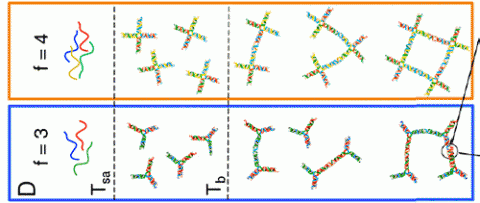BUILDING MATERIALS OF THE FUTURE WITH DNA

Phase behavior and critical activated dynamics of limited-valence DNA nanostars
Silvia Biffia, Roberto Cerbinoa, Francesca Bomboi, Elvezia Maria Paraboschia, Rosanna Asseltaa, Francesco Sciortino, and Tommaso Bellinia.
Significance
At atomic and molecular levels, particles interact via the immutable laws of quantum mechanics, whereas at nanoscopic and microscopic levels, interactions between colloidal particles can be determined by human design. We exploit DNA self-assembly to produce nanoscopic particles with a controlled number of interacting terminations, providing the particles with valence. Experimental investigation of the collective behavior of such colloids shows that reducing the number of interacting sites results in a significant shrinkage of the gas–liquid coexistence region, with critical parameters decreasing as the valence is reduced. We also observe an unconventional dynamic behavior in the proximity of the critical point. Such findings are relevant to answer fundamental physics issues and potentially to determine the stability region of new DNA-based materials.
Abstract
Colloidal particles with directional interactions are key in the realization of new colloidal materials with possibly unconventional phase behaviors. Here we exploit DNA self-assembly to produce bulk quantities of “DNA stars” with three or four sticky terminals, mimicking molecules with controlled limited valence. Solutions of such molecules exhibit a consolution curve with an upper critical point, whose temperature and concentration decrease with the valence. Upon approaching the critical point from high temperature, the intensity of the scattered light diverges with a power law, whereas the intensity time autocorrelation functions show a surprising two-step relaxation, somehow reminiscent of glassy materials. The slow relaxation time exhibits an Arrhenius behavior with no signs of criticality, demonstrating a unique scenario where the critical slowing down of the concentration fluctuations is subordinate to the large lifetime of the DNA bonds, with relevant analogies to critical dynamics in polymer solutions. The combination of equilibrium and dynamic behavior of DNA nanostars demonstrates the potential of DNA molecules in diversifying the pathways toward collective properties and self-assembled materials, beyond the range of phenomena accessible with ordinary molecular fluids.
Info
francesco.sciortino@uniroma1.it
T (+39) 0649913799
